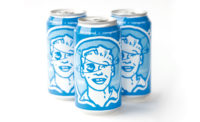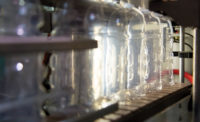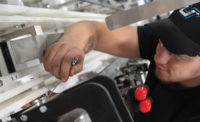Success in the packaging industry during the next 10 years will hinge upon building a deep understanding of and connection to the empowered consumer. As consumers place an increasing value on choice, control, convenience and experience, retailers will need to embrace disruptive technologies and novel approaches to manufacturing. One of the biggest transformations in the manufacturing supply chain will be in robotic automation. The demand for integration-ready, flexible machines that can accommodate rapid changeovers, a variety of sizes/SKUs and customized packaging is leading to exciting technologies that break the mold.
The Fourth Industrial Revolution & Consumer-Driven Manufacturing
The fourth industrial revolution has ushered in a new consumer-driven manufacturing landscape. The consumer is truly king in this new world where companies like Amazon have set a new standard for expectations around choice, control, convenience and experience. According to the World Economic Forum, globally, consumers have access to one billion different products. To keep pace with rising consumer expectations, manufacturers are tapping into new and novel approaches and technologies. Here we examine how dexterous, integration-ready, flexible robotic systems are addressing this monumental shift and paving the way for the factory of the future.
New Industries Turn to Automation for the First Time
There are several key drivers that are placing pressure on manufacturers to turn to robotic automation. Finding labor for repetitive, unskilled tasks like the picking and packing of goods has increasingly become a challenge, with manufacturer job postings up 280 percent according to the Bureau of Labor Statistics. As labor continues to become increasingly scarce, manufacturers are turning to automation to maintain their productivity and, in many cases, the economic viability of their product. An increase in consumers demanding more choices has contributed to shorter product life-cycles, shorter runs and more line changes.
We’ve seen the transformative impact automation has had on industries like automotive. Robots can increase throughput, accuracy and consistency — all while decreasing worker-related accidents and safety hazards. For the packaging industry, robotic automation unlocks the flexibility needed to meet shorter product life-cycles, new packaging designs, product variation and batch manufacturing.
The challenge, however, is that traditional robots have been designed to perform a single task extremely efficiently. But when the item or the task changes, which is increasingly becoming the case in packaged goods, these traditional machines need to be reintegrated and reprogrammed. And this can take hundreds of hours and significant capital investment. This is why so many industries have been reliant on human labor — and the human hand specifically — to pick and pack their items. The need for robots to solve for dexterous manipulation is stronger than ever. Even the U.S. government, in its 2016 Roadmap for Robotics report, cites “flexible gripping mechanisms that allow for dexterous manipulation of everyday objects” as a “national imperative.”1
With a single device, soft robotic grippers, such as Soft Robotics’ mGrip, can handle numerous products without expensive and time-intensive tool changes.
Robotic Automation Reaches New Industries and Applications
For decades automation was limited to industries like automotive and electronics, where conventional, rigid robots were adept at automating non-variable production lines. Due to technological advancements and declining robot prices, however, robots are today reaching new industries and previously inaccessible applications.
One example of an emerging technology in this space is soft robotics, a new field out of Harvard University focused on the development of biologically inspired “soft robots” that are able to mimic the dexterity of the human hand. Traditional robotic manufacturers have attempted to replicate the human hand with rigid linkages, sensors and sophisticated vision systems. Soft robotics’ novel approach solves this problem through material science, not through higher levels of cost and complexity. Inspired by the octopus and its ability to manipulate objects, a soft robotic gripper is made entirely of soft materials that do not require sensors or other electromechanical devices for operation. The computational power of the system is built into the gripper itself, a blend of materials with microfluidic channels that, when actuated, can manipulate items with human hand-like dexterity.
Enabling a Consumer-Centric Approach to Manufacturing
One of the greatest solutions to mounting consumer demands and SKU proliferation is innovations in the equipment on the factory floor. Here we examine how the dexterous, flexible and collaborative nature of soft robotics is enabling CPG manufacturers to meet new market requirements.
Pick-and-place applications: Robotic automation is fantastic at applications that demand speed, precision and repeatability. Products that are delicate and easily damaged have, until now, been primarily picked and packed off a conveyor belt by humans due to the risk of rigid grippers damaging the product. Soft robotic gripping solutions are able to maintain throughput requirements all while handling items with a “soft” touch. This opens up a multitude of new packaging possibilities for manufacturers.
Flexibility: With a single device, soft robotic grippers can handle an infinite number of products, without expensive and time-intensive tool changes. This is especially important in the packaging space, where an ever-increasingly number of SKUs translates to constant product variation and new packaging designs.
Efficient changeovers: The on-demand, modular nature of soft robotics enables faster, more efficient changeovers for manufacturers, lowering the threshold of volume and making automation a more economical option for smaller batch sizes/niche tasks. Not only can soft robotic grippers plug into all leading robotic arms, but the grippers themselves are modular and can be quickly and easily adapted to meet the specific needs of the application. The cost savings offered by this kind of low-volume automation could benefit many different kinds of organizations: Smaller manufacturers will be able to access robotic technology for the first time, and larger ones could increase the variety of their product offerings.
Collaborating safely with workers: New workplace legislation — and the need to reduce worker-related safety incidents — are compelling reasons to automate. Collaborative robots are designed specifically to work in close proximity to their human counterparts. They can relieve workers of monotonous, tiring and physical tasks, thereby increasing the quality and efficiency of human work. The soft materials used in the soft robotic gripper make it an excellent fit for collaborative applications. Soft Robotics has partnered with Universal Robotics to create a gripping system specifically tailored to collaborative robots and applications. With the SRDK-UR+, users can quickly address an infinite number of applications, such as machine tending, high-speed packaging, pick and place, assembly and CNC machine automation.
The pressure to meet constantly evolving consumer demands is creating new innovation in the packaging sector. Traditional industrial robotic systems were, until now, unable to handle packaging variability, personalization and small batch sizes — forcing manufacturers to rely on human labor to perform complex processing tasks on small batches and premium packaging. With the introduction of soft robotics, manufacturers are able to unlock the transformative power of robotic automation to meet the ever-changing needs of their customers.
Soft Robotics unlocks robotic automation for large markets and labor-starved industries such as food and beverage, advanced manufacturing, e-commerce and retail. Leveraging patented material science and AI algorithms, Soft Robotics designs and builds automation solutions and soft robotic gripping systems that can grasp and manipulate items with the same dexterity of the human hand. Please visit softroboticsinc.com or follow @softroboticsinc.





